Profile Features of Emulsified Asphalt Mixture Containing Steel Slag Based on Laser Scanning
Abstract
1. Introduction
2. Materials
2.1. Aggregate and Asphalt
2.2. Slurry Mixture
3. Research Methodologies
3.1. Particle Distribution
3.2. Aggregate Morphology Features
3.3. Laser Scanning of Surface Profile
3.4. Skid Resistance and Mechanical Property
4. Results and Discussion
4.1. Particle Distribution of Emulsified Asphalt
4.2. Aggregate Morphologies
4.3. Three-Dimensional Surface Models and Profile Indexes of MS
4.4. Skid-Resistance and Mechanical Property
5. Conclusions
- The color representing a higher position is the most widely distributed on 3D model of MS-steel slag and has the smallest distribution area in Type II samples. Uniformly-graded MS samples has an obvious graininess and higher texture depths compared with Type II.
- MPD values of three types of uniformly-graded MS samples are all more than twice as large as that of Type II, implying that singleness size of aggregate can effectively increase texture depth. Ra and RMS were found to have the similar rule with MPD. Rsk values of uniformly-graded samples are positive, while that of Type II is −0.045, manifesting that singleness size of aggregate can significantly increase the positive texture on the surface of MS. Moreover, since the edge slag is sharper and the shape is less circular than natural aggregate, steel slag can bring about larger profile indexes than basalt and limestone.
- Skid resistance of uniformly-graded samples is superior to Type II. The BPN value of MS-steel slag is the largest of four types of samples, which means the addition of steel slag can improve the skid resistance of MS samples.
- The 1-h result of Type II was significantly smaller than those of uniformly-graded, whereas their abrasion loss still meets the requirements of specification. The abrasion loss of steel slag after 6 days is significantly larger than ordinary samples, and exceeds the upper limit of the specification resulting from the volume expansion of steel slag. Therefore, steel slag needs to be aged to eliminate f-CaO before used as the aggregate in MS.
Author Contributions
Funding
Acknowledgments
Conflicts of Interest
References
- Zhang, Y.; Ma, T.; Ling, M.; Zhang, D.R.; Huang, X.M. Predicting dynamic shear modulus of asphalt mastics using discretized-element simulation and reinforcement mechanisms. J. Mater. Civ. Eng. 2019, 31, 04019163. [Google Scholar] [CrossRef]
- Chang, X.; Zhang, R.; Xiao, Y.; Chen, X.; Zhang, X.; Liu, G. Mapping of publications on asphalt pavement and bitumen materials: A bibliometric review. Constr. Build. Mater. 2020, 234, 117370. [Google Scholar] [CrossRef]
- Xue, Y.; Wei, X.; Zhao, H.; Wang, T.; Xiao, Y. Interaction of spent fcc catalyst and asphalt binder: Rheological properties, emission of vocs and immobilization of metals. J. Clean. Prod. 2020, 259, 120830. [Google Scholar] [CrossRef]
- Wang, F.; Xiao, Y.; Cui, P.; Lin, J.; Chen, Z. Correlation of asphalt performance indicators and aging degrees: A review. Constr. Build. Mater. 2020, 250, 118824. [Google Scholar] [CrossRef]
- Ding, X.; Ma, T.; Huang, X. Discrete-element contour-filling modeling method for micromechanical and macromechanical analysis of aggregate skeleton of asphalt mixture. J. Transp. Eng. Part B Pavements 2019, 145, 04018056. [Google Scholar] [CrossRef]
- Xu, B.; Li, M.L.; Liu, S.H.; Fang, J.; Ding, R.D.; Cao, D.W. Performance analysis of different type preventive maintenance materials for porous asphalt based on high viscosity modified asphalt. Constr. Build. Mater. 2018, 191, 320–329. [Google Scholar] [CrossRef]
- Pellecuer, L.; Assaf, G.J.; St-Jacques, M. Life cycle environmental benefits of pavement surface maintenance. Can. J. Civ. Eng. 2014, 41, 695–702. [Google Scholar] [CrossRef]
- Bannour, A.; Omari, M.E.; Lakhal, E.; Afechkar, M.; Benamar, A.; Joubert, P. Optimization of the maintenance strategies of roads in morocco: Calibration study of the degradations models of the highway development and management (hdm-4) for flexible pavements. Int. J. Pavement Eng. 2019, 20, 245–254. [Google Scholar] [CrossRef]
- Wei, L.; Ju, H.J.; Tighe, S.L.; Shao, N.N.; Sun, Z.Y. An innovative primary surface profile-based three-dimensional pavement distress data filtering approach for optical instruments and tilted pavement model-related noise reduction. Road Mater. Pavement Des. 2019, 20, 132–150. [Google Scholar]
- Weiss, P.T.; Kayhanian, M.; Gulliver, J.S.; Khazanovich, L. Permeable pavement in northern north american urban areas: Research review and knowledge gaps. Int. J. Pavement Eng. 2019, 20, 143–162. [Google Scholar] [CrossRef]
- Bashar, M.Z.; Elseifi, M.A.; Mousa, M.R.; Zhang, Z.; Gaspard, K. Optimizing the Performance of Microsurfacing Treatments in Flexible Pavements and Assessing Its Effects on Moisture Damage. Transp. Res. Rec. 2019, 2673, 217–229. [Google Scholar] [CrossRef]
- Sun, X.; Zhang, X. Experimental study on high performance micro-surfacing. J. Tongji Univ. Nat. Sci. 2012, 40, 867–870. [Google Scholar]
- Alavi, S.; Tanzadeh, J.; Honarmand, M.; Mirhosseini, A. Performance Evaluation of Hybrid Fibers and Nano-zeolite Modified Asphalt Micro-surfacing. J. Test. Eval. 2020, 48, 2412–2431. [Google Scholar] [CrossRef]
- Liu, M.; Han, S.; Wang, Z.; Ren, W.; Li, W. Performance evaluation of new waterborne epoxy resin modified emulsified asphalt micro-surfacing. Constr. Build. Mater. 2019, 214, 93–100. [Google Scholar] [CrossRef]
- Wang, A.; Shen, S.; Li, X.; Song, B. Micro-surfacing mixtures with reclaimed asphalt pavement: Mix design and performance evaluation. Constr. Build. Mater. 2019, 201, 303–313. [Google Scholar] [CrossRef]
- Zalnezhad, M.; Hesami, E. Effect of steel slag aggregate and bitumen emulsion types on the performance of microsurfacing mixture. J. Traffic Transp. Eng. Engl. Edit. 2020, 7, 215–226. [Google Scholar] [CrossRef]
- Cui, P.D.; Wu, S.P.; Xiao, Y.; Yang, C.; Wang, F. Enhancement mechanism of skid resistance in preventive maintenance of asphalt pavement by steel slag based on micro-surfacing. Constr. Build. Mater. 2020, 239, 117870. [Google Scholar] [CrossRef]
- El-Desouky, A. Investigating the effect of temperature variations on the measured airfield pavement skid resistance. Constr. Build. Mater. 2018, 161, 649–653. [Google Scholar] [CrossRef]
- Araujo, V.M.C.; Bessa, I.S.; Branco, V.T.F.C. Measuring skid resistance of hot mix asphalt using the aggregate image measurement system (aims). Constr. Build. Mater. 2015, 98, 476–481. [Google Scholar] [CrossRef]
- Kehagia, F. Skid resistance performance of asphalt wearing courses with electric arc furnace slag aggregates. Waste Manag. Res. 2009, 27, 288–294. [Google Scholar] [CrossRef]
- Xiao, Y.; Wang, F.; Cui, P.; Lei, L.; Lin, J.; Yi, M. Evaluation of fine aggregate morphology by image method and its effect on skid-resistance of micro-surfacing. Materials 2018, 11, 920. [Google Scholar] [CrossRef] [PubMed]
- Wu, S.P.; Xue, Y.J.; Ye, Q.S.; Chen, Y.C. Utilization of steel slag as aggregates for stone mastic asphalt (sma) mixtures. Build. Environ. 2007, 42, 2580–2585. [Google Scholar] [CrossRef]
- Ahmedzade, P.; Sengoz, B. Evaluation of steel slag coarse aggregate in hot mix asphalt concrete. J. Hazard. Mater. 2009, 165, 300–305. [Google Scholar] [CrossRef] [PubMed]
- Xue, Y.J.; Wu, S.P.; Hou, H.B.; Zha, J. Experimental investigation of basic oxygen furnace slag used as aggregate in asphalt mixture. J. Hazard. Mater. 2006, 138, 261–268. [Google Scholar] [CrossRef] [PubMed]
- Qian, Z.D.; Liu, Y.; Liu, C.B.; Zheng, D. Design and skid resistance evaluation of skeleton-dense epoxy asphalt mixture for steel bridge deck pavement. Constr. Build. Mater. 2016, 114, 851–863. [Google Scholar] [CrossRef]
- Outline Guide Design Procedure for Slurry Seal; Design Technical Bulletins 111; International Slurry Surfacing Association: Annapolis, MD, USA, 2017.
- Gao, J.; Wang, H.; Bu, Y.; You, Z.; Hasan, M.R.M.; Irfan, M. Effects of coarse aggregate angularity on the microstructure of asphalt mixture. Constr. Build. Mater. 2018, 183, 472–484. [Google Scholar] [CrossRef]
- Cui, P.; Xiao, Y.; Yan, B.; Li, M.; Wu, S. Morphological characteristics of aggregates and their influence on the performance of asphalt mixture. Constr. Build. Mater. 2018, 186, 303–312. [Google Scholar] [CrossRef]
- Cong, L.; Wang, T.J. Effect of fine aggregate angularity on skid-resistance of asphalt pavement using accelerated pavement testing. Constr. Build. Mater. 2018, 168, 41–46. [Google Scholar]
- Kuo, C.Y.; Freeman, R.B. Imaging indices for quantification of shape, angularity, and surface texture of aggregates. Transp. Res. Rec. 2000, 1721, 57–65. [Google Scholar] [CrossRef]
- Zhang, J.; Weng, X.Z.; Liu, J.Z.; Yang, B.H.; Wen, X.P.; Wang, T. Anti-slip and wear resistance performance of three novel coatings as surface course of airstrip. Int. J. Pavement Eng. 2018, 19, 370–378. [Google Scholar] [CrossRef]
- Roslan, N.H.; Ismail, M.; Khalid, N.H.A.; Muhammad, B. Properties of concrete containing electric arc furnace steel slag and steel sludge. J. Build. Eng. 2020, 28, 101060. [Google Scholar] [CrossRef]
- Rooholamini, H.; Sedghi, R.; Ghobadipour, B.; Adresi, M. Effect of electric arc furnace steel slag on the mechanical and fracture properties of roller-compacted concrete. Constr. Build. Mater. 2019, 211, 88–98. [Google Scholar] [CrossRef]
- Kim, K.; Jo, S.H.; Kim, N.; Kim, H. Characteristics of hot mix asphalt containing steel slag aggregate according to temperature and void percentage. Constr. Build. Mater. 2018, 188, 1128–1136. [Google Scholar] [CrossRef]
- Masoudi, S.; Abtahi, S.M.; Goli, A. Evaluation of electric arc furnace steel slag coarse aggregate in warm mix asphalt subjected to long-term aging. Constr. Build. Mater. 2017, 135, 260–266. [Google Scholar] [CrossRef]
- Fakhri, M.; Ahmadi, A. Evaluation of fracture resistance of asphalt mixes involving steel slag and rap: Susceptibility to aging level and freeze and thaw cycles. Constr. Build. Mater. 2017, 157, 748–756. [Google Scholar] [CrossRef]
- Ortega, L.V.; Manso, J.M.; Cuesta, I.I.; Gonzalez, J.J. The long-term accelerated expansion of various ladle-furnace basic slags and their soil-stabilization applications. Constr. Build. Mater. 2014, 68, 455–464. [Google Scholar] [CrossRef]
- Wang, Q.; Yan, P.; Feng, J. A discussion on improving hydration activity of steel slag by altering its mineral compositions. J. Hazard. Mater. 2011, 186, 1070–1075. [Google Scholar] [CrossRef]
- Yin, X.; Zhang, C.; Wang, G.; Cai, Y.; Zhao, C. Stabilization of free cao in molten bof slag by addition of silica at high temperature. Metall. Res. Technol. 2018, 115, 414. [Google Scholar] [CrossRef]
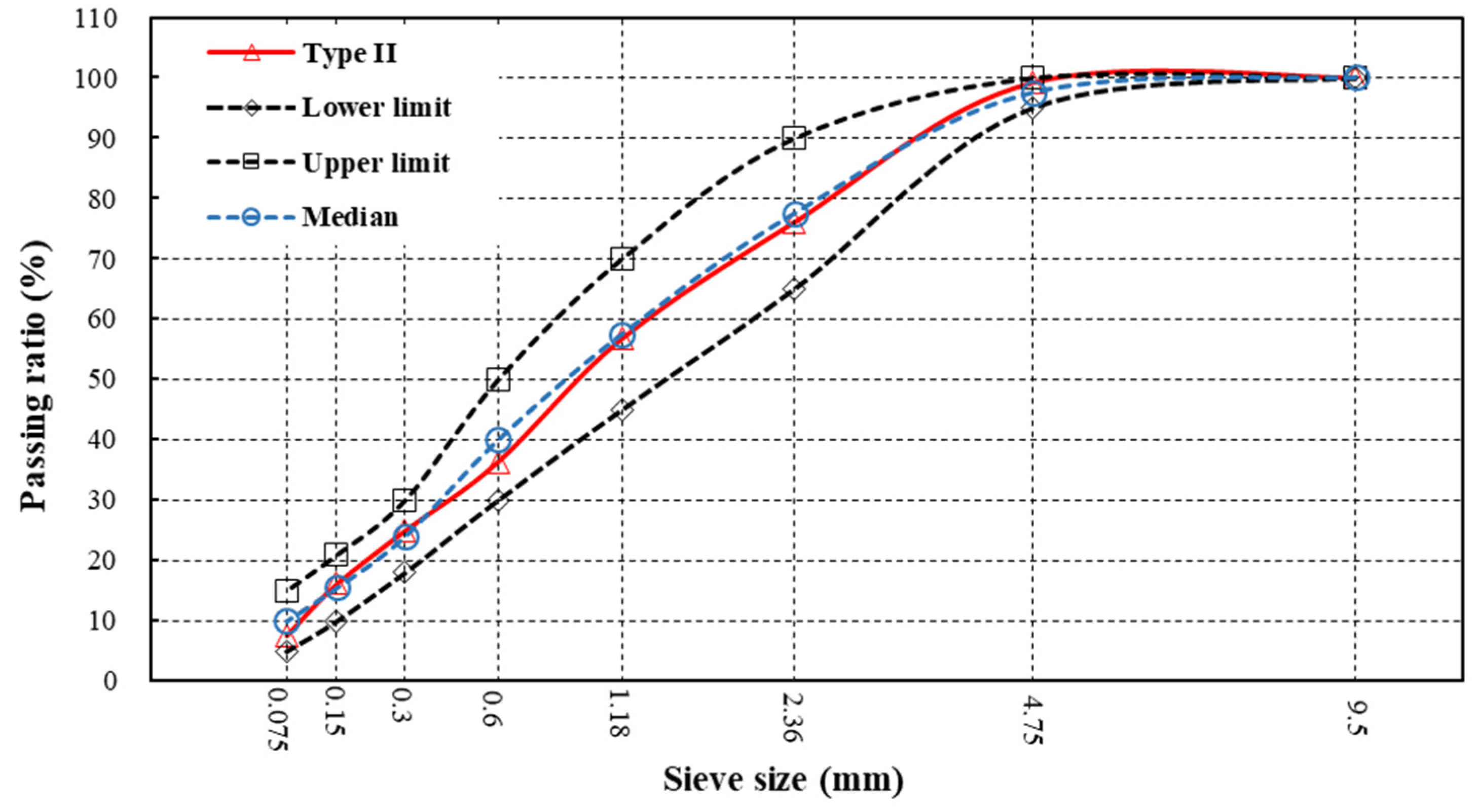

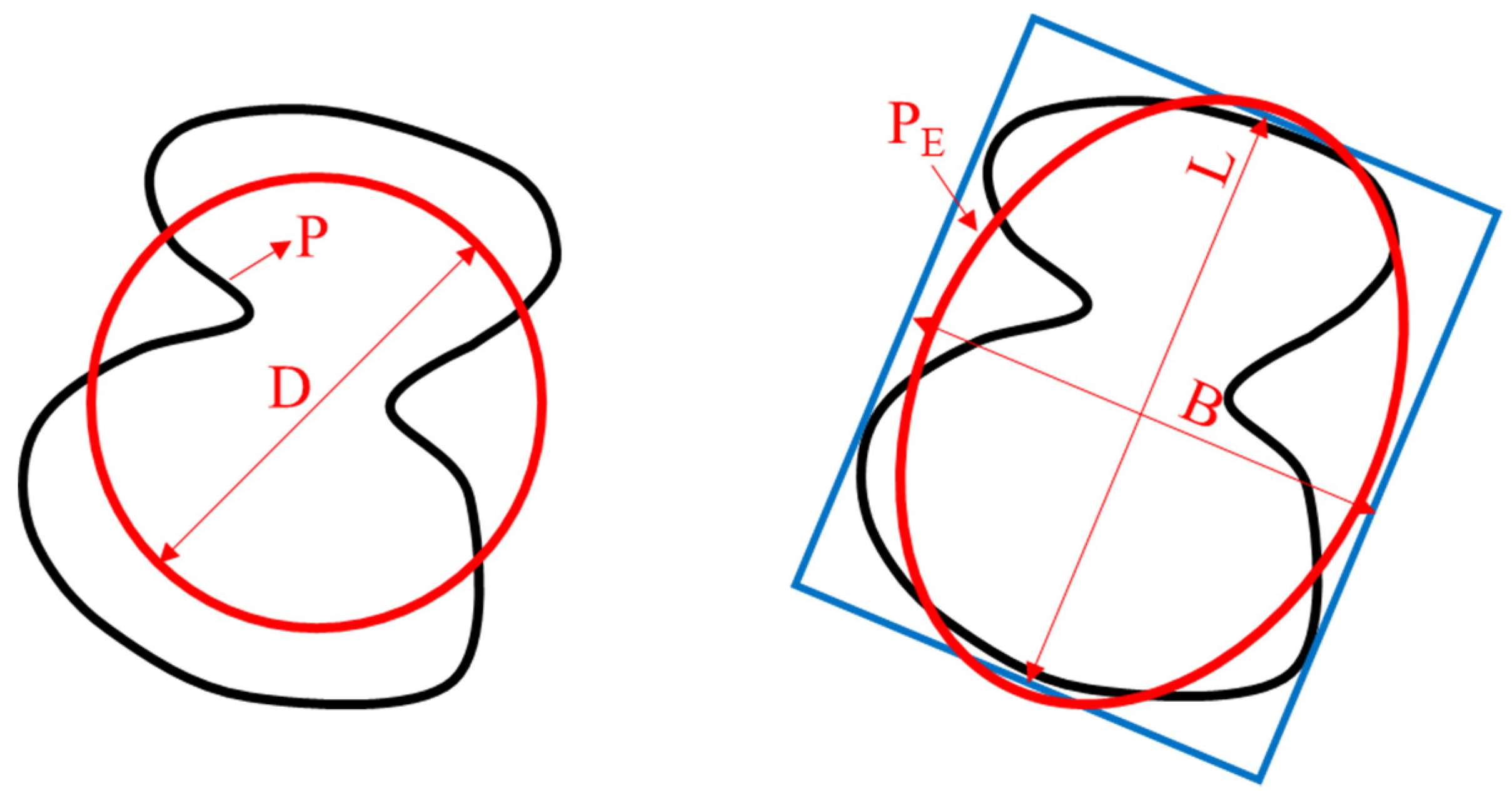

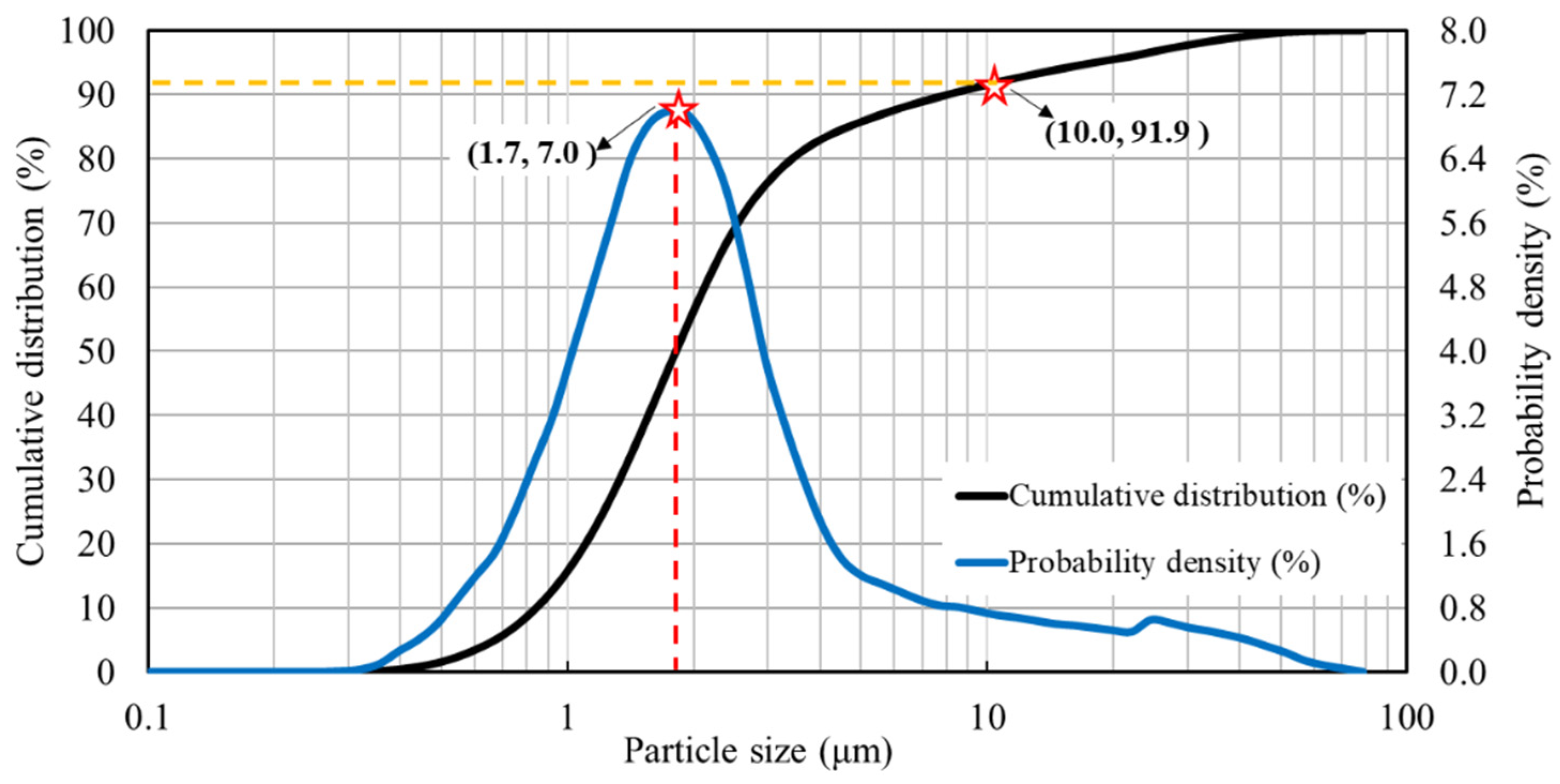
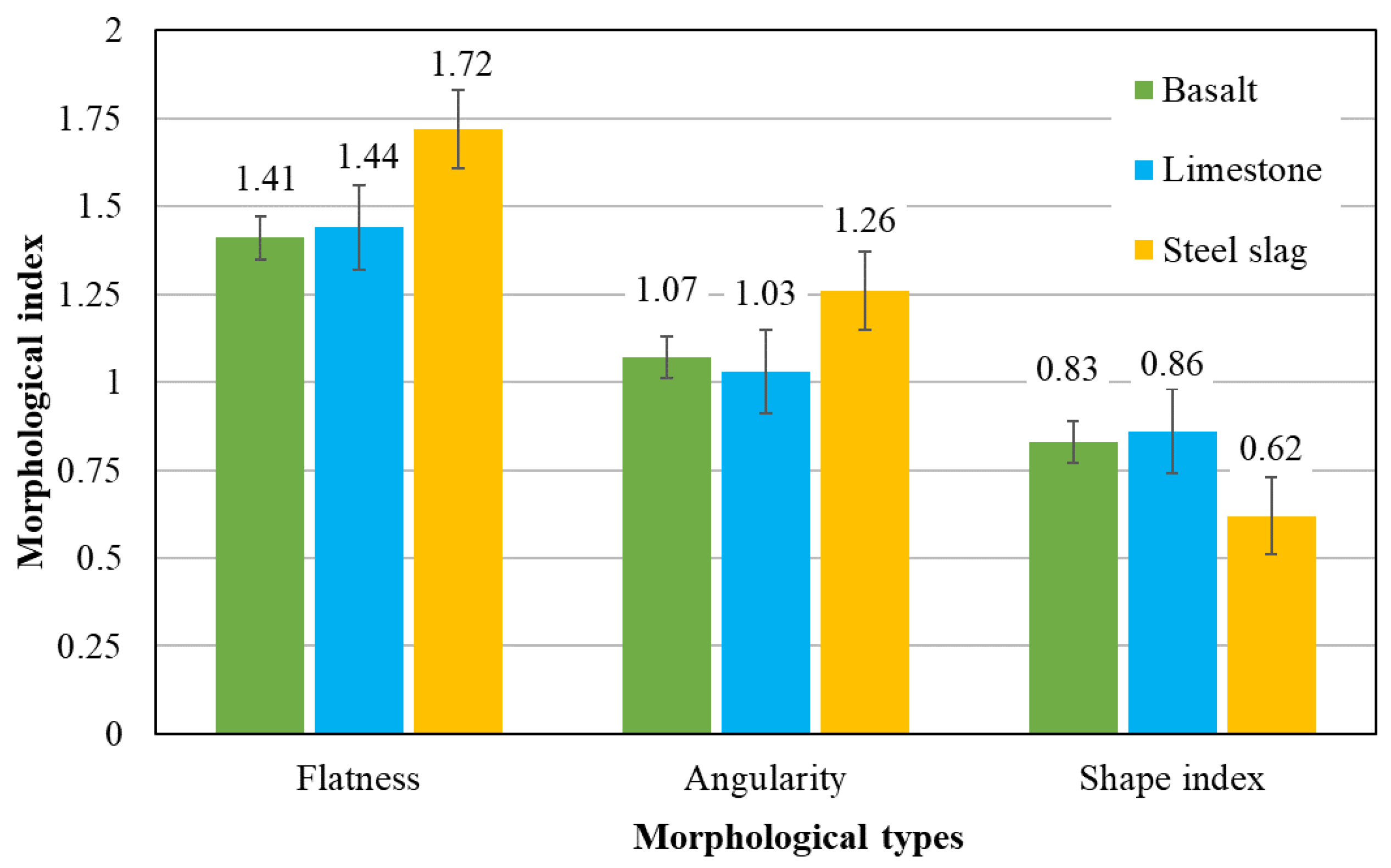
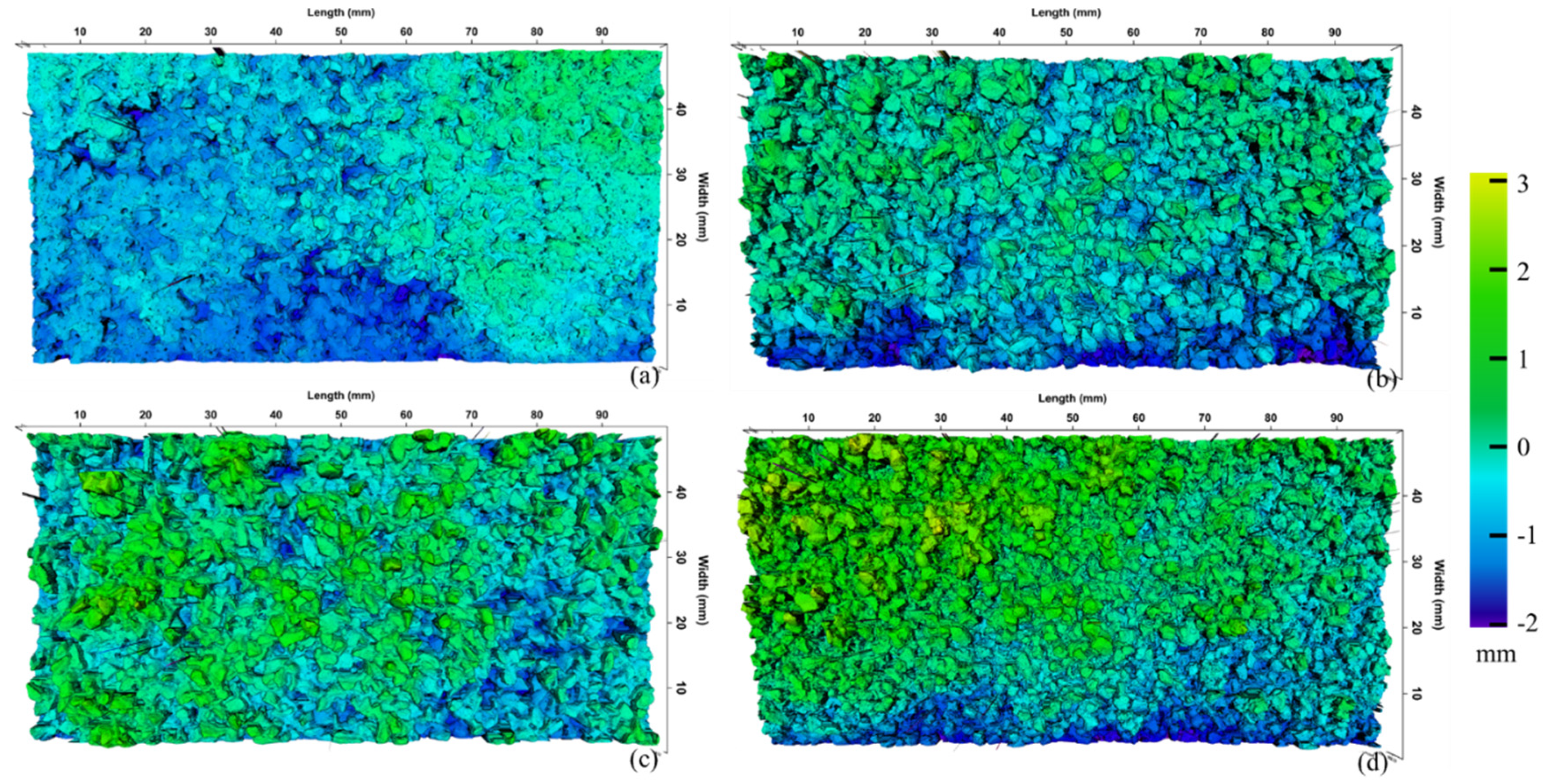
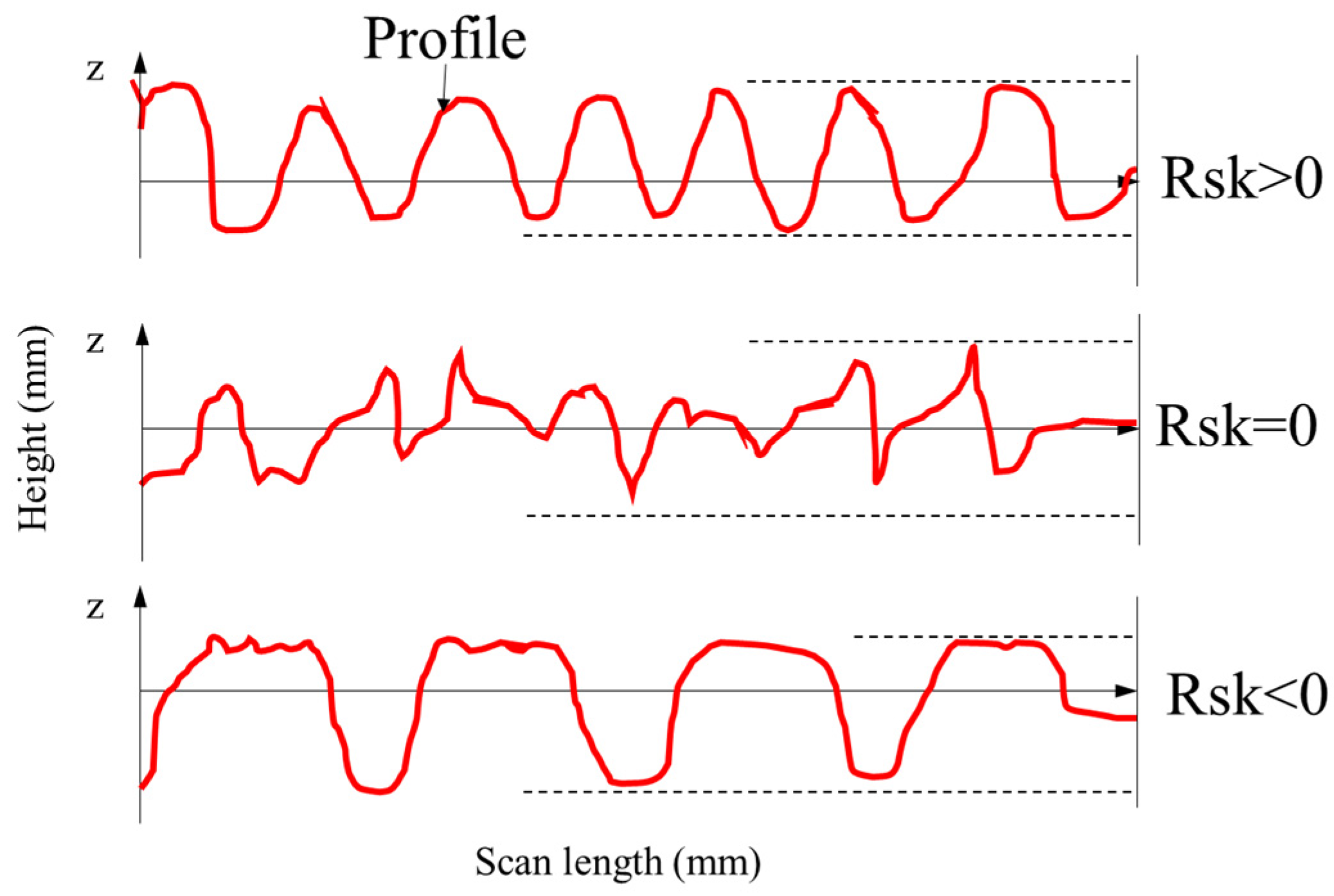
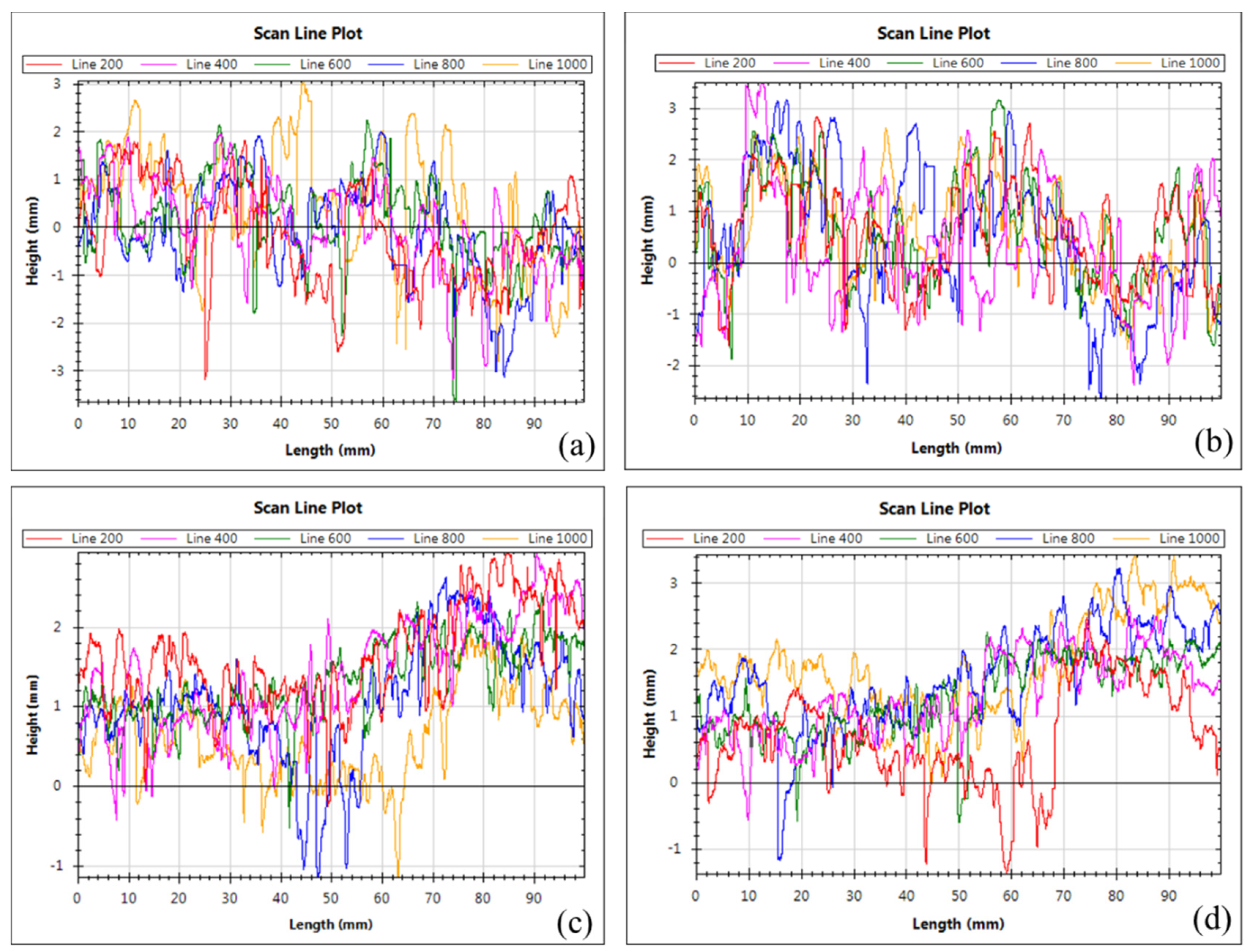

| Properties | Basalt | Limestone | Steel Slag | Criterion |
|---|---|---|---|---|
| Sand equivalent (%) | 68 | 71 | 75 | ASTM D419 |
| Soundness (%) | 15.7 | 15.1 | 13.6 | ASTM C88 |
| Specific gravity | 2.978 | 2.708 | 2.872 | ASTM C127 |
| Properties | Performance | Criterion |
|---|---|---|
| Distillation (%) | 61 | ASTM D 7497 |
| Softening point (°C) | 56 | ASTM D 36 |
| Penetration (0.1 mm) | 62 | ASTM D 5 |
| Ductility (cm) | >100 | ASTM D 113 |
| Charge | positive | ASTM D 244 |
| Stability-24 h (%) | 0.7 | ASTM D 6930 |
| Slurry Mixtures | Abbreviation | Cement | Water | Asphalt Content |
|---|---|---|---|---|
| MS made of limestone | MS-limestone | 1% | 6.5% | 5.1% |
| MS made of basalt | MS-basalt | 1% | 6.5% | 4.8% |
| MS made of steel slag | MS-steel slag | 1% | 6.5% | 5.5% |
| Type II | - | 1% | 7.5% | 6.8% |
| Parameters | Description |
|---|---|
| D | Diameter of the equivalent area circle |
| P | Length of aggregate’s outline |
| L | Length of major axis |
| B | Length of minor axis |
| PE | Perimeter of the equivalent ellipse |
| Profile Index | Equation | Type II | MS-Basalt | MS-Limestone | MS-Steel Slag | |
|---|---|---|---|---|---|---|
| MPD | (5) | 0.885 | 1.776 | 1.794 | 1.863 | |
| Ra | (6) | 0.529 | 0.806 | 0.769 | 0.961 | |
| RMS | (7) | 0.505 | 0.919 | 0.997 | 1.013 | |
| Rsk | (8) | −0.045 | 0.332 | 0.345 | 0.388 | |
© 2020 by the authors. Licensee MDPI, Basel, Switzerland. This article is an open access article distributed under the terms and conditions of the Creative Commons Attribution (CC BY) license (http://creativecommons.org/licenses/by/4.0/).
Share and Cite
Wang, F.; Cui, P.; Zhang, X.; Yunusa, M.; Xiao, Y. Profile Features of Emulsified Asphalt Mixture Containing Steel Slag Based on Laser Scanning. Materials 2020, 13, 2679. https://doi.org/10.3390/ma13122679
Wang F, Cui P, Zhang X, Yunusa M, Xiao Y. Profile Features of Emulsified Asphalt Mixture Containing Steel Slag Based on Laser Scanning. Materials. 2020; 13(12):2679. https://doi.org/10.3390/ma13122679
Chicago/Turabian StyleWang, Feng, Peide Cui, Xiaoshan Zhang, Mujaheed Yunusa, and Yue Xiao. 2020. "Profile Features of Emulsified Asphalt Mixture Containing Steel Slag Based on Laser Scanning" Materials 13, no. 12: 2679. https://doi.org/10.3390/ma13122679
APA StyleWang, F., Cui, P., Zhang, X., Yunusa, M., & Xiao, Y. (2020). Profile Features of Emulsified Asphalt Mixture Containing Steel Slag Based on Laser Scanning. Materials, 13(12), 2679. https://doi.org/10.3390/ma13122679






